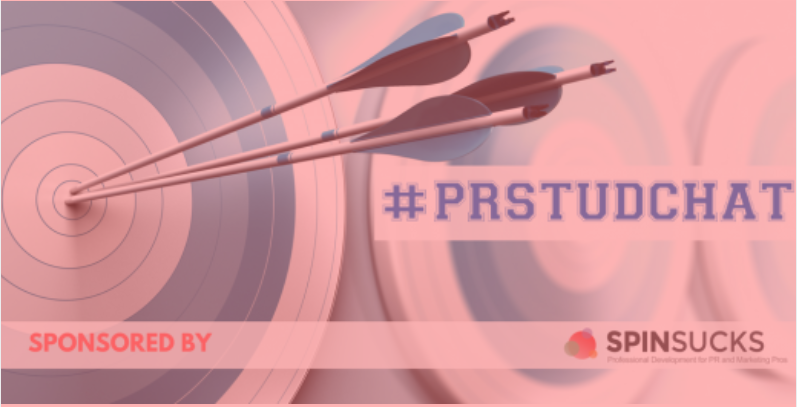 Media pitching.
Media pitching.
You know what it is, but, as our leading #PRStudChat question asked last week, in a world where blogs are often more widely read than traditional media, and communication includes texting, emoji, DMing, and live video chat, how important is it?
Because, really, content is king, right (says the content creator)?
That said, if the PESO model has taught us anything, it’s that we need to integrate a number of distribution tactics into the communications mix in order to be consistently successful.
#PRStudChat: Dispelling the Mystery
This month’s PR Student Chat focused on dispelling the mystery around media pitching, so we recruited media pitching-expert Michael Smart to pull aside the curtain and provide some insight into the world of media pitching in today’s communications environment.
A former newspaper journalist, Michael has won national and regional awards for news release and feature writing.
He has also taught public relations courses at Brigham Young University, where he earlier earned bachelors and master’s degrees in communications with an emphasis in public relations.
Michael Smart dispenses PR wisdom every Thursday to more than 9,000 active subscribers to his popular email newsletter.
#PRStudChat: Redefining Media
Out of the gate, Michael made sure to address just what it means when we say “media”.
“Media” is any third-party that’s trusted by an audience you want to reach. Pitch blogs, social influencers, other companies’ content marketing, even celebs. #PRStudChat
— Michael Smart (@michaelsmartpr) September 20, 2018
Makes sense, right?
Media is no longer limited to “traditional” media. In fact, some brands may not even want coverage from mainstream media, knowing that their desired audience trusts local content sources, or niche/micro influencers with a better understanding of their product or service.
In terms of how you can gauge that trust?
Most overlooked approach: ask members of your key audience. After that, watch behavioral indicators – if a blogger recommends a book, does its Amazon sales rank climb?
— Michael Smart (@michaelsmartpr) September 20, 2018
#PRStudChat: Characteristics of a Good Media Pitch
Okay. Media isn’t defined the same way it was back in the day (does that make me sound old?).
A blogger, Instagrammer, YouTuber, or Twitcher (is that what people on Twitch are called?) who are trusted by your audience fall nicely into the media category.
But do they follow the so-called “rules” of media pitching? By extension, do the same rules apply?
According to Michael, it’s just like content creation itself.
Is this timely? Relevant? Is it something the “media” outlet in question thinks their audience will be interested in? Cover those bases, and you will all be on the same page.
Twitter-length answer: intensely and immediately relevant to the recipient’s needs
— Michael Smart (@michaelsmartpr) September 20, 2018
The key(s)? Research and strategy. Don’t underestimate the value of knowing your target audience, and the audience of the media you are pitching.
Yet almost every team that I work with does so. Bosses/clients pay too much $$ for outputs (number of pitches, online articles posted) and not enough for strategy.
— Michael Smart (@michaelsmartpr) September 20, 2018
#PRStudChat: Unanswered Media Pitches 🙁
Ugh. Media pitching is hard. I sent a snappy email (yes, he also says email remains the best way to pitch), and my media pitch was still get ignored. Why?!?
A3: Reason 1: Influencer too busy at that moment to notice (solution – follow up). Reason 2. Irrelevant (solution – pitch someone else who cares)
— Michael Smart (@michaelsmartpr) September 20, 2018
Whoops. Did you do your research? Remember: Know your audience!
#PRStudChat: Media Pitching Tips
Apart from that? Michael has some tips:
A4. Faux formality dominates most pitches. Kill it and be conversational. Also, keep pitches to three grafs and end with a helpful but direct call to action. #PRStudChat
— Michael Smart (@michaelsmartpr) September 20, 2018
Faux formality?
“Dear Mr. Smart, As you are no doubt aware, the greater Boston tech ecosystem is dominated by multinational corporations with scintillating PR teams. Would you be interested in three symposia calibrated to highlight their strengths at an opportune time?”
— Michael Smart (@michaelsmartpr) September 20, 2018
Some other examples!
Although now I kind of want to start some of my emails like this… “Greetings! How doth thou farest on this finest of days?” #PRStudChat ^MC https://t.co/vtTjyK9XSl
— Spin Sucks (@SpinSucks) September 20, 2018
And, an additional tip:
A3. Obviously a brief teaser subject line targeted to their needs helps.
— Michael Smart (@michaelsmartpr) September 20, 2018
#PRStudChat: Check out the Chat!
We don’t want to give away all #PRStudChat’s amazing insights!
Please follow along on Twitter by checking out the hashtag results on September 20, 2018, or check out the feed below.
(Note: there were some minor technical glitches during the chat, so the feed below is a little out of order. Sorry!)
Remember, if you ever have questions before or during the chat, you can tweet @PRStudChat, @SpinSucks, @LKPetrolino, @ValerieSimon or @DBreakenridge with any questions you would like answered.
Otherwise, please join us in the free Spin Sucks Community where we discuss #PRStudChat themes at length, along with many other like-minded issues (we may get off track now and then, but that’s part of the fun).
About #PRStudChat
As always, PR Student Chat—co-founded by Deirdre Breakenridge and Valerie Simon—partners with trusted industry leaders to help shed light on the ever-changing issues that affect our role as professionals.
It helps students, and practitioners alike, learn from the experience and perspective of other industry professionals.
In addition, it’s a community where everyone can learn and grow together.
Please stay tuned for our next session, topic, and guest host.